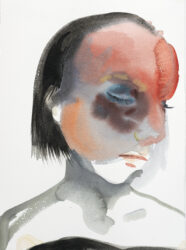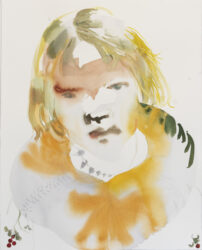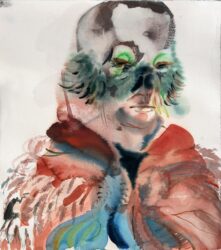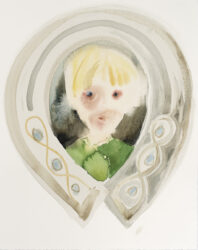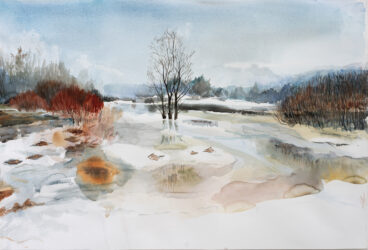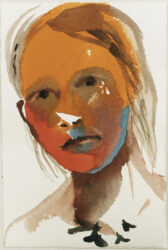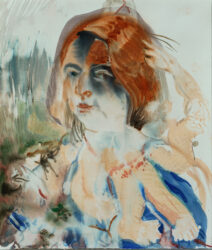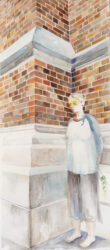Hanna Saarikoski
MIRRORS FOR PRINCES
15.5.2024 — 9.6.2024
My work is not strictly thematic; rather, it combines subjects that revolve in the subconscious and how the painting intuitively chooses its elements. While working on this exhibition, themes such as Kikimora of the Swamps, Vasilisa the Wise, Christine de Pisan, and the decorations of the Vasa ship have been present, either beneath the surface or more directly. The present moment, clay bricks, the crumbling Tetris of dreams and utopias. Everything must be rebuilt again and again, in a new position, a new possibility; there is no other option.
Hanna Saarikoski
Mirrors for Princes
A Russian folk tale describes its heroine, Vasilisa the Wise, as follows: “She was such a beauty, the kind you can’t invent or imagine, the kind you only find in fairy tales.” However, it is possible to try to imagine and depict. Even abstract concepts such as power, everyday life, or freedom can be illustrated.
The Vasa ship, intended to be the pride of the Swedish navy, set off on its maiden voyage in 1628. The ship was richly decorated with colorful wooden sculptures meant to symbolize the power of the Swedish king and intimidate enemies. The Vasa sank because its center of gravity was too high. In fairy tales, the theme often involves restoring balance between good and evil or in the affairs of the tsar’s realm. In these stories, real, secret power is often held by an old woman like Baba Yaga, rather than in the luxury of palaces.
Vasilisa the Wise’s crime was to be born wiser and cleverer than her father. As punishment, her jealous father sentenced Vasilisa to live three years as a frog. The tsar’s son, who fell in love with Vasilisa, burns her frog skin while she is temporarily in human form, and naturally, things go awry. The tsarevich did not allow Vasilisa to be who she was. When men do not let women be who they are or become who they can be, problems arise.
Christine de Pizan wrote her work “The Book of the City of Ladies” in 1405 specifically for other women. In it, abstract concepts take on female forms. Lady Reason, Lady Honesty, and Lady Justice depict a city for women, a refuge for virtuous women in a misogynistic world. De Pizan demanded the right for women to receive education and self-development. In an illustration from the book, women are laying bricks to build the walls of their city. The pieces of society are being placed in a new order.
Katja Matikainen
Instagram: @hannaelisaarikoski
Hanna Saarikoski (born 1978, Kannus, lives and works in Somero) graduated with a Master of Fine Arts from the Academy of Fine Arts, Department of Painting, in 2008. In her production, she combines painting, drawing, video art, installations, and performative elements. Saarikoski’s works have been exhibited in numerous solo and group exhibitions in Finland, including Mänttä Art Festival 2012, Aboa Vetus & Ars Nova, Kiasma, and Emma.
Thanks to Arts promotion center of Finland for supporting my work and the exhibition.


